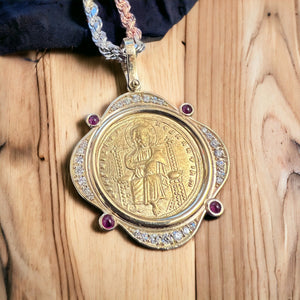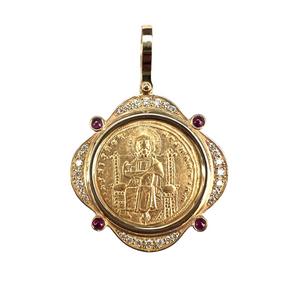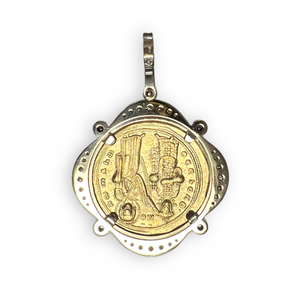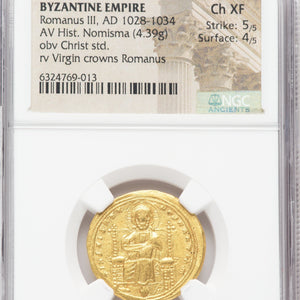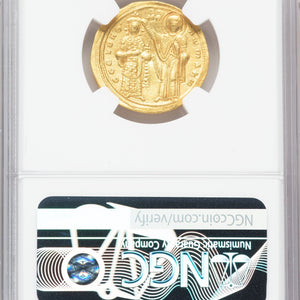Ancient Byzantine gold coin - AV Histamenon (Nomisma) - Romanus III (Argyrus) - (AD 1028-1034).
$5,200
Capture the power of ancient Byzantine history with this rare gold histamenon coin, created in AD 1028-1034 under Romanus III Argyrus. The obverse features a large Christ enthroned with nimbus cruciger, pallium and colobium, & the reverse displays the emperor and Virgin crowning him with a globus cruciger. Command the weight of history with this powerful piece of gold!
Denomination: AV Histamenon (Nomisma).
Date: Circa: 1028 – 1034 AD
Mint: Constantinople.
Weight: 4.39 g
Mount: 18K gold - 0.50 CT dia - 0.36 CT Rubies
Grade: NGC – 6324769-013 - Choice XF Strike: 5/5 Surface: 4/5
Description: Romanus III Argyrus. Obverse: Latin (+IhS XIS RЄX-RЄϚNANTInm), Christ enthroned facing, wearing nimbus cruciger, pallium and colobium, right hand raised in benediction, book of Gospels in left; double border. Reverse: Latin (ΘCЄ bOHΘ'-RwmAhw), standing facing figures of Romanus III (on left), bearded, wearing crown with pendilia, saccos and loros, four pellets on sleeve, globus cruciger in left hand, and the Virgin (on right), nimbate, wearing pallium and maphorium, crowning emperor with right hand; decorative element over MΘ in central field between their heads, double border.
History: histámenon, "standard coin” was the name given to the gold Byzantine solidus when the slightly lighter tetarteron was introduced in the 960s. Ever since Emperor Constantine I introduced it in 309, the Byzantine Empire's main coinage had been the high-quality solidus or nomisma, which had remained standard in weight (4.55 grams) and gold content (24 carats) through the centuries. Emperor Nikephoros II Phokas (963–969), introduced a new coin, the [nomisma] tetarteron ("quarter coin") which was 2 carats lighter than the original nomisma. The latter now became known as the histamenon, from the Greek verb ἵστημι, "to stand up", implying that these followed the traditional standard. The reasons for this change are not clear; Byzantine chroniclers, however, suggest fiscal motives, reporting that Nikephoros collected the taxes in the histamenon. while paying back with the tetarteron.
61207






